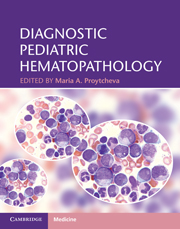Book contents
- Frontmatter
- Contents
- List of contributors
- Acknowledgements
- Introduction
- Section 1 General and non-neoplastic hematopathology
- 1 Hematologic values in the healthy fetus, neonate, and child
- 2 Normal bone marrow
- 3 Disorders of erythrocyte production
- 4 Disorders of hemoglobin synthesis
- 5 Hemolytic anemias
- 6 Inherited and acquired bone marrow failure syndromes associated with multiple cytopenias
- 7 Inherited bone marrow failure syndromes and acquired disorders associated with single peripheral blood cytopenia
- 8 Peripheral blood and bone marrow manifestations of metabolic storage diseases
- 9 Reactive lymphadenopathies
- Section 2 Neoplastic hematopathology
- Index
- References
6 - Inherited and acquired bone marrow failure syndromes associated with multiple cytopenias
from Section 1 - General and non-neoplastic hematopathology
Published online by Cambridge University Press: 03 May 2011
- Frontmatter
- Contents
- List of contributors
- Acknowledgements
- Introduction
- Section 1 General and non-neoplastic hematopathology
- 1 Hematologic values in the healthy fetus, neonate, and child
- 2 Normal bone marrow
- 3 Disorders of erythrocyte production
- 4 Disorders of hemoglobin synthesis
- 5 Hemolytic anemias
- 6 Inherited and acquired bone marrow failure syndromes associated with multiple cytopenias
- 7 Inherited bone marrow failure syndromes and acquired disorders associated with single peripheral blood cytopenia
- 8 Peripheral blood and bone marrow manifestations of metabolic storage diseases
- 9 Reactive lymphadenopathies
- Section 2 Neoplastic hematopathology
- Index
- References
Summary
Overview
Bone marrow failure syndrome consists of a group of rare diseases with the defining features of ineffective/defective hematopoiesis by the bone marrow and resultant peripheral cytopenia [1, 2]. Bone marrow failure can be attributed to a variety of mechanisms, such as loss of pluripotent hematopoietic stem cells; bone marrow replacement by metastatic carcinoma, lymphoma, leukemia or fibrosis; nutritional/metabolic disorder leading to maturation arrest or clonal hematopoietic stem neoplasm such as myelodysplastic syndromes. Aplastic anemia is the paradigm of the human bone marrow failure syndrome, characterized by peripheral cytopenia and a hypocellular marrow [1, 3, 4]. Injury to or loss of pluripotent hematopoietic stem cells, in the absence of an infiltrative disease of the bone marrow, is the major pathophysiologic characteristic of the disease [3, 4]. Aplastic anemia can result from either inherited or acquired causes. This chapter will discuss the bone marrow failure syndromes, both inherited and acquired, that are associated with multiple cytopenias.
Inherited bone marrow failure syndromes
The inherited bone marrow failure syndromes in children comprise a group of rare congenital disorders in which the bone marrow is unable to produce blood cells effectively resulting in unilineage or multilineage cytopenia (Table 6.1). These syndromes may present with or without physical anomalies [5]. Patients with inherited bone marrow failure syndromes are at risk for severe cytopenia, development of marrow cytogenetic abnormalities, myelodysplastic syndromes (MDS), and other malignancies [6].
- Type
- Chapter
- Information
- Diagnostic Pediatric Hematopathology , pp. 90 - 103Publisher: Cambridge University PressPrint publication year: 2011



